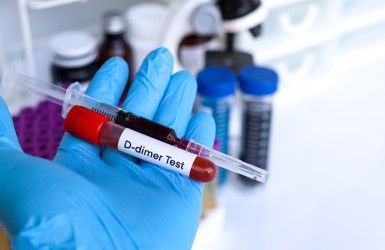General Health
Sudden Chest Pain or Swollen Legs? Check for Blood Clots with the D-dimer Test
6 min read
By Apollo 24|7, Published on - 29 May 2025
Share this article
0
0 like

Chest pain and leg swelling are symptoms that can’t be ignored. They might indicate something as serious as a blood clot — a condition that, if left untreated, could become life-threatening. In such cases, your doctor may advise a D-dimer test, a simple blood test that plays a critical role in ruling out or diagnosing potentially fatal clotting disorders.
Let’s explore what this test is, when it’s needed, how it works, and what you should do if you’re asked to undergo one.
Understanding D-dimer Test
The D-dimer test is a diagnostic blood test used to detect fragments of protein called D-dimer in the blood. These fragments are produced when a blood clot gets broken down in the body. Normally, D-dimer levels are undetectable or very low. But when there's significant clot formation and breakdown — such as in deep vein thrombosis (DVT) or pulmonary embolism (PE) — these levels rise significantly.
In simple terms, this test tells doctors whether your body is actively forming and dissolving blood clots.
Why the D-dimer Test Matters
This test is especially valuable because it helps to rule out dangerous conditions quickly. Some of the most serious medical emergencies linked to blood clots include:
- Deep vein thrombosis (DVT): A clot in a deep vein, typically in the leg, which can cause swelling, warmth, and pain.
- Pulmonary embolism (PE): A life-threatening condition where a clot travels to the lungs, causing chest pain, coughing, or breathlessness.
- Stroke: A blood clot in the brain can cause sudden neurological symptoms like weakness or confusion.
- Disseminated intravascular coagulation (DIC): A serious disorder where multiple clots form throughout the body, affecting organs.
- Post-surgical clotting risk: Patients after major surgery are also monitored for abnormal clotting activity using the D-dimer test.
If your symptoms suggest one of these, your doctor might use the D-dimer test as the first step in diagnosis.
Symptoms That May Warrant a D-dimer Test
Knowing when to seek help is critical. Your doctor may recommend the D-dimer test if you show signs or symptoms such as:
- Sudden chest pain, especially with breathing difficulty
- Swollen, painful, or warm leg (often one-sided)
- Unexplained shortness of breath
- Coughing up blood
- Rapid heart rate
- Sudden, severe headache or vision changes
- Persistent bleeding or easy bruising
These symptoms could indicate a clot forming or moving through the body. The D-dimer test helps to assess whether this is happening.
Preparing for the D-Dimer Test
In most cases, no special preparation is required. However, you should:
- Inform your doctor about any medications you are taking (especially blood thinners or hormonal treatments)
- Mention if you are pregnant or recently had surgery
- Let them know about any recent injuries or illnesses
These factors may affect your results and will help your doctor interpret the findings accurately.
How the Test Is Performed
The D-dimer test is straightforward and quick. A small blood sample is taken from a vein in your arm. You don’t need to fast or follow any special dietary restrictions beforehand. The sample is sent to a laboratory for analysis, and in most cases, the results are available within a few hours, especially if you're in an emergency department.
Understanding Your Results
D-dimer test results are usually reported as either "positive" (elevated levels) or "negative" (normal levels). The normal range for a D-dimer test is generally considered to be less than 500 ng/mL (nanograms per milliliter). Lower D-dimer levels suggest a lower likelihood of blood clots or clotting disorders. Higher levels may indicate a possible clotting disorder.
Normal Levels (Negative D-dimer Test)
Typically, a D-dimer level of less than 500 ng/mL is considered within the normal range.
- A negative result is reassuring.
- It usually means there’s no significant blood clot in the body.
This can help your doctor confidently rule out clot-related conditions, particularly in people with low to moderate risk.
Elevated Levels (Positive D-dimer Test)
Higher than normal D-dimer levels may indicate a potential clotting disorder and warrant further investigation.
- A positive result means there is an elevated amount of D-dimer in the blood.
- This could be due to a blood clot — but not always.
- Other causes of elevated D-dimer include:
- Recent surgery
- Trauma or injury
- Liver disease
- Pregnancy
- Infections
Inflammatory conditions (e.g., rheumatoid arthritis)
Important note: A positive D-dimer test does not confirm a clot, but it raises suspicion and prompts further investigation, such as an ultrasound or CT scan.
Have more questions?
Next Steps After a D-Dimer Test
If your D-dimer levels are high, your doctor may order additional imaging tests to locate a clot and assess its size and location. These may include:
- Ultrasound scan: Often used to check for DVT in the legs.
- CT pulmonary angiography: The gold standard to detect pulmonary embolism.
- MRI scans: Less commonly used but helpful in complex cases.
- Venography or angiography: Specialised imaging to visualise blood vessels.
These follow-up tests help form a clear diagnosis, allowing for timely treatment. Based on the results, your healthcare provider will develop an appropriate treatment plan, which may involve anticoagulant medications or other interventions.
Benefits of the D-dimer Test
- Non-invasive and simple: Just a routine blood draw.
- Quick results: Often within hours.
- Reduces unnecessary imaging: Helps avoid CT scans or ultrasounds when not needed.
- Cost-effective: Less expensive than advanced imaging studies.
- Useful for ongoing monitoring: Especially in patients at high risk for recurrent clots.
Risks Associated with the D-Dimer Test
The D-dimer test is generally safe, with minimal risks. As with any blood draw, you may experience:
- Mild pain or bruising at the puncture site
- Light-headedness or dizziness (rare)
- A slight risk of infection at the site
- Rarely, there may be bleeding or fainting.
These are generally short-lived and don’t pose significant health threats.
Living with the positive D-Dimer Test
If you've had a positive D-dimer test followed by confirmation of a clot, your treatment plan may include:
- Anticoagulants (blood thinners): These help prevent new clots from forming and existing ones from growing.
- Compression stockings: Used to manage symptoms and reduce the risk of post-thrombotic syndrome.
- Lifestyle modifications: Includes staying hydrated, avoiding prolonged sitting, regular exercise, and quitting smoking.
- Your doctor may monitor your D-dimer levels periodically, especially if you’re at risk for recurrent clots.
Conclusion
The D-dimer test is a vital first step in evaluating patients with symptoms like sudden chest pain, leg swelling, or unexplained shortness of breath. It doesn’t diagnose blood clots directly but offers valuable information that guides further investigation and treatment. If you or someone you know is showing warning signs, don’t delay. Early testing and diagnosis can save lives and prevent severe complications like stroke or pulmonary embolism.
Always follow your doctor's advice, and never ignore symptoms that feel unusual or severe. Your body often gives you signals — listen to them, and seek help early.
General Health
Frequently Asked Questions
What is the D-dimer test used for?
What is the D-dimer test used for?
Is a high D-dimer level always due to a blood clot?
Is a high D-dimer level always due to a blood clot?
Can I eat before a D-dimer test?
Can I eat before a D-dimer test?
What does a negative D-dimer test mean?
What does a negative D-dimer test mean?
How soon will I get my results?
How soon will I get my results?
Leave Comment
Recommended for you

General Health
Enlarged Adenoids: Causes, Symptoms and Remedies
Enlarged adenoids can block the nasal passage of the air, resulting in congestion, breathing difficulties, and other symptoms.

General Health
10 Natural Remedies for Urinary Tract Infection
Discover 10 natural remedies for urinary tract infection treatment. From herbal supplements to lifestyle changes, find effective solutions for UTI treatment.
.jpg?tr=q-80)
General Health
Vitamin D Vegetables: How To Include Vitamin D-Rich Vegetables In Your Diet
Discover the best vitamin D-rich vegetables and easy ways to include them in your meals. Boost your vitamin D intake naturally for better health!
Subscribe
Sign up for our free Health Library Daily Newsletter
Get doctor-approved health tips, news, and more.
Visual Stories

The Best Exercises for Controlling Blood Sugar Levels
Tap to continue exploring
Recommended for you

General Health
Enlarged Adenoids: Causes, Symptoms and Remedies
Enlarged adenoids can block the nasal passage of the air, resulting in congestion, breathing difficulties, and other symptoms.

General Health
10 Natural Remedies for Urinary Tract Infection
Discover 10 natural remedies for urinary tract infection treatment. From herbal supplements to lifestyle changes, find effective solutions for UTI treatment.
.jpg?tr=q-80)
General Health
Vitamin D Vegetables: How To Include Vitamin D-Rich Vegetables In Your Diet
Discover the best vitamin D-rich vegetables and easy ways to include them in your meals. Boost your vitamin D intake naturally for better health!